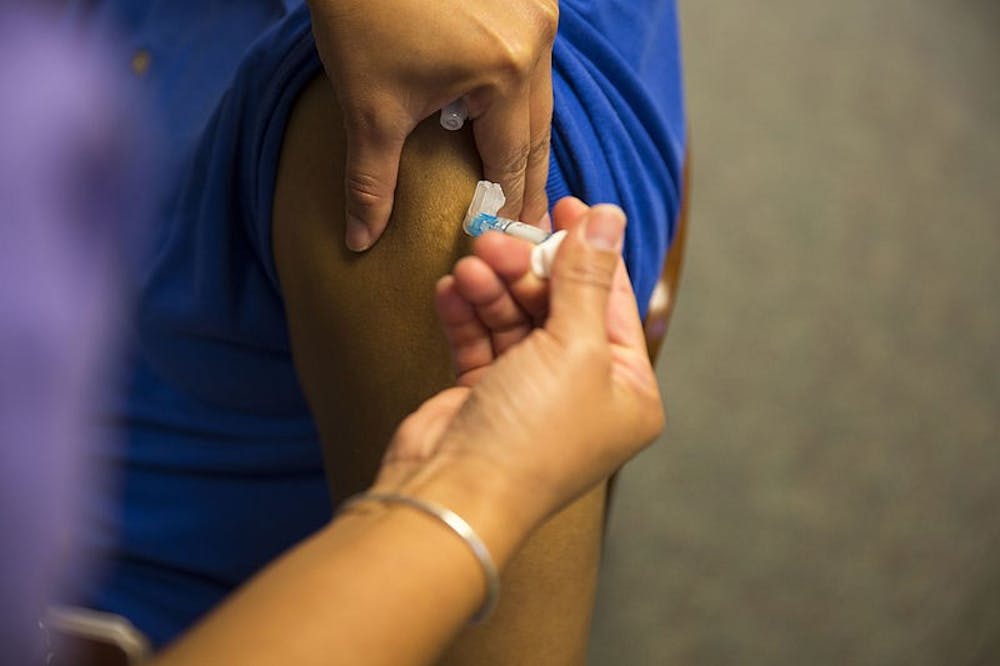The University Department of Student Health offered its annual flu shot clinic for students on Tuesday, Oct. 2. While the clinic had some advantages, such as appointments for the clinic were not being necessary and the many Student Health staff members that were present to help students in a quick and efficient manner, there were some very real problems with how it was administered that limited its accessibility. If the University is serious about reducing influenza rates amongst the student body, vaccinations must become far more accessible for students.
Firstly, the clinic was only offered on one day. While the 10 a.m. to 7 p.m. window of time was extensive and the Newcomb Ballroom location was central, offering the clinic over the course of a few days would be more practical for students with varying schedules. The Elson Student Health Center does offer these vaccines year-round, however, they are appointment-only and available from 8:30 a.m. until 4 p.m. when many students have classes and other school events. An effective vaccination program would work around busy student schedules to prevent as many appointment conflicts as possible.
In addition to the single day that the vaccinations were offered, the flu clinic was not extensively advertised to students — two emails were sent out, one on Sept. 28 and another on the day of the clinic. The emails were perhaps a failure in terms of publicizing the event. In fact, a report from the National Foundation for Infectious Diseases recommends that vaccination programs should be advertised in a student-driven way. For example, the University of Wisconsin-Madison has a “student-inclusive workgroup” that assists in advertising campaigns that encourage vaccinations. Additionally, the report notes that the most successful advertising campaigns extend past solely email, such as advertising over multiple forms of social media. In order for a broad range of students to know about the clinic, the University should follow these guidelines to better publicize the event.
The clinic’s single-insurance acceptance policy could also limit vaccinations. Most insurance companies do cover flu shots, and often encourage them as well. Thus, the University’s single-insurance acceptance policy does not reflect the wide availability of compensated vaccines. Although all students must have a University-approved insurance policy, the availability of free vaccines are still limited only to students with Aetna insurance coverage. Making sure that vaccinations would be available for students over the course of several days in a central location on Grounds, while accepting more insurance policies would surely encourage students to get vaccinated.
The University of Virginia Health System clearly encourages students to get a flu shot every year, specifically saying that, “For the best protection, get vaccinated as soon as the vaccine is available in your area.” However, the practical implementation of this sentiment came with significant shortcomings. If the University wants to protect the health of students during flu season, a program that would be more accessible for students would help achieve this goal.
The University should take action because vaccination rates for full-time college students are very low. In fact, NBC reported that in 2016 the vaccination rates were, “as low as 8 percent and only as high as 39 percent.” Thus, a well-advertised vaccination program would heavily benefit all communities on Grounds, especially due to the heightened risk for flu that many college students suffer. This, of course, can be prevented with a flu vaccine. According to an article published in the Journal of Biomedical Sciences, “amongst those aged 18-49 years in the United States, it is estimated that over 300,000 cases per year of influenza can be prevented by vaccination alone.” Even though many believe that the flu vaccine is often ineffective and can vary, it is still the best defense against the virus.
There are many factors that lower the immune system which are common on any college campus. For example, stress, lack of sufficient sleep, alcohol consumption and dehydration can all increase the risk of catching the flu. Furthermore, students living in close quarters are at an especially higher flu risk due to the shared living spaces and restrooms.
The 2017-18 influenza season was a particularly dangerous flu season. In fact, the Center for Disease Control claimed the past flu season to be, “the first season to be classified as a high severity across all age groups,” after a change in the classification system in 2003. By the first week of October 2017, people had already begun needing hospitalization for the flu. Moreover, the flu season specifically in Virginia mirrored the severity of the season on a national scale. It is not possible to predict the severity and exact strains of the flu that will affect each season, but another equally high-risk season is always feasible.
Each year, the flu season can be extremely dangerous and it is vastly important to protect both oneself and the people that one comes in contact with every day. The University can help its students to do so by making the flu clinic widely available for a wider range of schedules and insurance plans.
Victoria McKelvey is a Viewpoint Writer for The Cavalier Daily. She can be reached at opinion@cavalierdaily.com.





